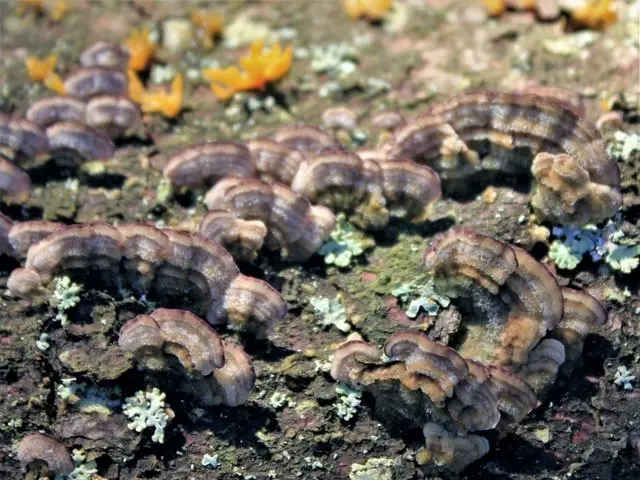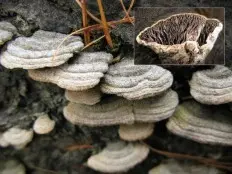Contents
Trihaptum elovy (Trihaptum abietinum)
- Division: Basidiomycota (Basidiomycetes)
- Subdivision: Agaricomycotina (Agaricomycetes)
- Class: Agaricomycetes (Agaricomycetes)
- Subclass: Incertae sedis (of uncertain position)
- Order: Polyporales (Polypore)
- Family: Polyporaceae (Polyporaceae)
- Genus: Trichaptum (Trichaptum)
- Type: Trihaptum abietinum (Trihaptum elovy)
:

Spruce Trihaptum can grow prostrate – completely or with a bent edge – but most often dead trunks adorn its caps attached to the side. The size of the caps is small, from 1 to 4 cm wide and up to 3 cm deep. They are located in very numerous groups, in long rows or tiled, sometimes along the entire fallen trunk. They are semicircular or fan-shaped, thin, dry, with hairy bristly pubescence; painted in grayish tones; with a purple edge and concentric zones that differ in both color and surface texture. Epiphytic algae like to settle on them, from which the surface turns green. Last year’s specimens are “sleek”, whitish, the edge of the caps is tucked inward.
Hymenophore painted in beautiful purple tones, much brighter towards the edge, gradually fading to purple-brown with age; when damaged, the color does not change. At first, the hymenophore is tubular, with 2-3 angular pores 1 mm, but with age it usually becomes irpex-shaped (resembles blunt teeth in shape), and in prostrate fruiting bodies it is irpex-shaped from the very beginning.
Leg absent.
the cloth whitish, hard, leathery.
spore powder white.
microscopic features
Spores 6-8 x 2-3 µ, smooth, cylindrical or with slightly rounded ends, non-amyloid. The hyphal system is dimitic; skeletal hyphae 4-9 µ thick, thick-walled, without clamps; generative – 2.5-5 µ, thin-walled, with buckles.

Trihaptum spruce is an annual mushroom. It is one of the first to populate dead trunks, and if we consider only tinder fungi, then it is the first. Other tinder fungi appear only when its mycelium begins to die. Saprophyte, grows only on dead wood of conifers, mainly spruce. Period of active growth from spring to late autumn. Widespread species.

Trihaptum larch (Trichaptum laricinum)
In the northern range of larch, a very similar larch trihaptum is widespread, which, as its name implies, prefers dead larch, although it can also be seen on large deadwood of other conifers. Its main difference is the hymenophore in the form of wide plates.

Trihaptum brown-violet (Trichaptum fuscoviolaceum)
Another similar inhabitant of coniferous deadwood – brown-violet trihaptum – is distinguished by a hymenophore in the form of radially arranged teeth and blades, turning into serrated plates closer to the edge.

Trihaptum biforme (Trichaptum biforme)
It is easiest to distinguish spruce trihaptum from a very similar, albeit larger, twofold trihaptum, which grows on fallen hardwood, especially on birch, and does not occur on conifers at all.
Photo in article gallery: Marina.









